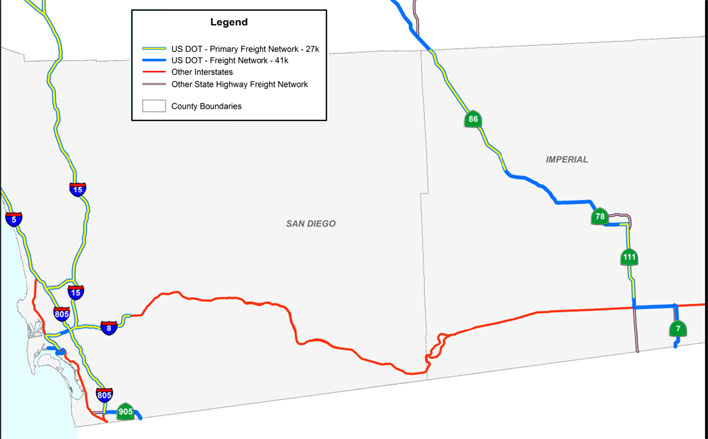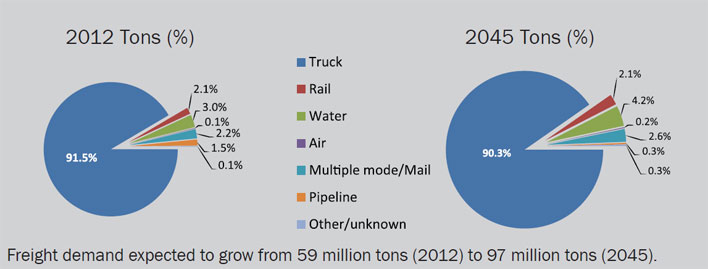U.S. Department of Transportation
Federal Highway Administration
1200 New Jersey Avenue, SE
Washington, DC 20590
202-366-4000
Freight Economy
Date: March 21, 2016
Our Host: Otay Mesa Chamber of Commerce and the San Diego Regional Chamber of Commerce
| HIGHWAYS | I-5, I-8, I-15, I-805, SR-7, SR-11. SR-86 SR-186 and SR-188 | |
| RAILROADS | BNSF, Union Pacific, San Diego and Imperial Valley, Desert Line Railroads | |
| AIRPORTS | San Diego International Airport | |
| WATERBORNE | Port of San Diego, M-5 Marine Corridor | |
| BORDER PORT | San Ysidro, Otay Mesa , Otay Mesa East (SR 11, proposed), Tecate, and Calexico East (Imperial county) |

Source: CalTrans, SANDAG
| Commodity | Value (millions $) | % of total |
|---|---|---|
| Electronics | 116,864 | 31% |
| Precision instruments | 35,627 | 9% |
| Machinery | 29,861 | 8% |
| Mixed freight | 28,261 | 7% |
| Motorized vehicles | 25,832 | 7% |
| All commodities | 379,945 | 100% |
| Commodity | Tons (thousands) | % of total |
|---|---|---|
| Nonmetal min. prods. | 9,808 | 10% |
| Other foodstuffs | 8,931 | 9% |
| Natural sands | 7,383 | 8% |
| Mixed freight | 6,977 | 7% |
| Waste/scrap | 6,959 | 7% |
| All commodities | 96,911 | 100% |
| Trade partner | Tonnage | % of total |
|---|---|---|
| California | 4,239 | 27% |
| Mexico | 2,974 | 19% |
| Canada | 2,049 | 13% |
| Eastern Asia | 1,699 | 11% |
| Texas | 740 | 5% |
| Total outbound | 15,748 | 100% |
| Trade partner | Tonnage | % of total |
|---|---|---|
| California | 21,563 | 52% |
| Eastern Asia | 4,921 | 12% |
| Mexico | 3,095 | 7% |
| Rest of Americas | 3,026 | 7% |
| Canada | 2,218 | 5% |
| Total inbound | 41,287 | 100% |
Based on FAF4.1 data with base year 2012 and forecasts up to 2045

The San Diego Area will see multimodal freight activity grow by nearly 65% in tonnage terms and more than double by value between 2012 and 2045.
The San Diego region’s freight activity is mostly domestic (85% by value and 89% by tonnage) but international freight value will likely quadruple by 2045.
San Diego’s share of truck freight activity is significantly higher (92%) than the national average (70%; tonnage based).
Major north-south corridors (I-5, I-805, and I-15) handle much truck activity. SR 125 connects to Otay Mesa port via SR 905. I-8 runs east- west, connecting CA to AZ.
A SANDAG study on operational strategies related to the use of managed lanes by trucks is currently underway.
Right now, San Diego’s major trading partner by both value (over one third) and tonnage (over half) is the rest of California.
By 2045, trade with the rest of the state will still be key but international trade will increase, especially with Mexico and East Asia.
Freight Intensive sectors such as trade, manufacturing, transportation, and construction account for almost 44% (out of 1.2 million) jobs in the San Diego region. Freight is an economic driver of the region.
Trade value at San Diego’s Otay Mesa gateway (the main land port in the region and California’s largest port of entry with Mexico) was $39.2 billion in 2014. Carried by over 1.6 million truck crossings annually, key commodities in this U.S.-Mexico trade are electronics, agricultural goods, vehicles, and medical devices.
The most significant freight bottleneck in the San Diego Area is at the I-5 and U.S. 163 interchange. Delays at and around the Otay Mesa land port of entry on the U.S.-Mexico border also produce a key regional freight bottleneck.
Sources for Freight Facts: FAF, BLS, ATRI, Caltrans and SANDAG
To view PDF files, you can use the Adobe® Reader®.